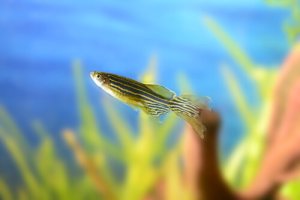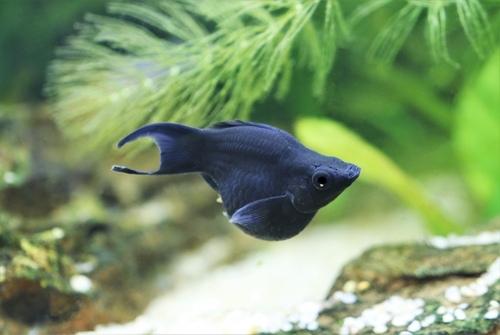
Molly fish are peaceful and enigmatic little tankmates that are best known for the fact they are livebearers. Yes, that’s right – these fish actually give birth to live young. As a result, you may purchase some Molly Fish and wish to breed them. Or, you may have ended up with an accidental pregnancy on your hands.
Either way, this guide will show you how to look after a pregnant Molly, covering everything from feeding to the moment that your fish gives birth.
How Do Molly Fish Mate?
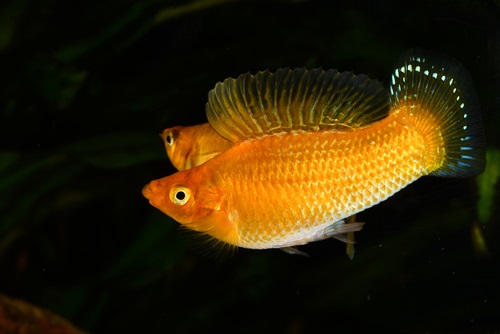
Of course, your Molly Fish will not get pregnant without mating. For many species of fish, it is tricky to get them to mate. However, with Mollies and some other related livebearers such as Guppies, the difficulty is preventing this! As surely as your fish swim in the water, you may find that in a tank with both females and males, you end up with a pregnant Molly fish.
If you are familiar with how Guppies mate, you will also recognize Molly fish breeding habits. Molly fish males mate by two different methods of behavior. These are courtship and sneaking. Sneaking involves a male Molly approaching an unsuspecting female to mate with her, whilst courtship involves the male and female wooing each other with behavior such as fin waggling.
Once the female is receptive to mating, the male will impregnate herewith a specialized anal fin called a gonopodium, which is relatively large in comparison to body size, and from which he sprays his milt. Like mammals, these fish hold their eggs inside their uterus, however, unlike mammals they are still cold-blooded and are not particularly attentive parents.
Mating can happen very quickly, so quickly you might mistake it for normal chasing behaviors.
How To Tell If You Have A Pregnant Molly Fish
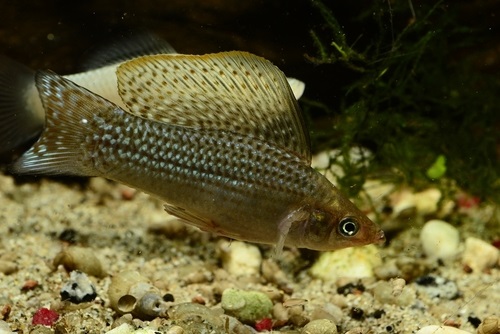
So, you suspect that your Molly fish have mated, or that you have a pregnant female Molly fish? How can you tell for sure? Fortunately, there are a wide variety of ways to determine pregnancy in Molly fish.
Behavior Changes
One noticeable early sign of pregnancy in Molly fish is behavior changes. At this stage, you may wonder whether your fish is sick. Simply put, when pregnant, Molly fish show behavior associated with sick fish such as lethargy, hiding, and swimming more slowly.
Thus, it’s really important to check whether they show other signs of pregnancy. Thus you can determine how you need to treat your fish.
Gravid Spot
The most surefire indicator of pregnancy in Molly fish is the gravid spot. This is a dark, triangular-shaped spot near the anal fin of the fish. It starts off as a light color and as the pregnancy progresses, it becomes darker until it is a dark brown or black before the fish is about to give birth.
Visual Changes
Another very easy, but not 100% certain, way of telling if your Molly fish is pregnant, is if they have a distended or enlarged stomach.
This can be a sign of some serious diseases such as GI issues, constipation, other digestive upset, or even dropsy, a serious bacterial infection of the kidneys.
However, if your fish doesn’t look noticeably sick, just a bit tired, and is still eating at least a bit of food, you can fairly certainly determine that your fish is actually carrying young.
Overall, if you see all these signs together, and your fish does not seem particularly sick, it’s a great indicator that you will soon be the owner of a batch of Molly fish fry!
How Long Are Molly Fish Pregnant?
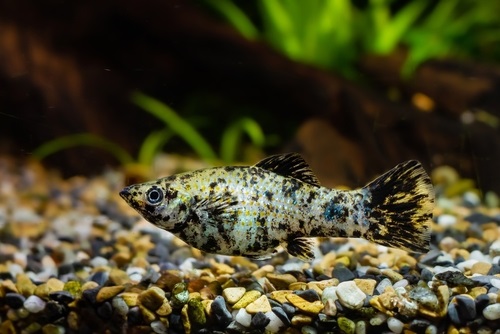
So, you’ve determined your Molly is pregnant. But, how long are Molly Fish pregnant?
Essentially, these guys carry the fish fry until they are ready to give birth for a gestation period of 40-60 days, although up to 70 days have been reported in some fish such as the Dalmatian Molly.
Why does Molly fish gestate for so long? These fish have another unusual feature, aside from being livebearers. After they have been impregnated with the male’s milt, they can actually store it within their body and self-fertilize their eggs.
This useful characteristic means they can ensure they only get pregnant at a time when they feel healthy and safe, are free from predation, and conditions in the tank are right. However, this is not always as effective a method as immediate fertilization.
Therefore, if you are certain your fish have mated but gestation is taking longer than expected… this might be why!
Author’s Note: Once the fish is ready to give birth, the labor process will begin, which can last up to 24 hours or even more. These fish experience contractions, again, just like mammals. Molly fish can give birth to over 80 free swimming live young which are often curled into a ball as they exit the mother’s uterus.
Setting Up A Breeding Tank

If you want to ensure your pregnant Molly fish gives birth without a hitch, it’s best to set up a separate breeding tank of at least 10 gallons (38 liters).
Other fish harassing your pregnant molly can be a major problem as males will still try and mate with her even when she is carrying fry. You should remove your Molly so that she doesn’t get harassed by tankmates. Even tankmates of a different species like the betta fish that normally get on with Mollies can become a source of stress for a pregnant fish.
Feeding Your Pregnant Molly
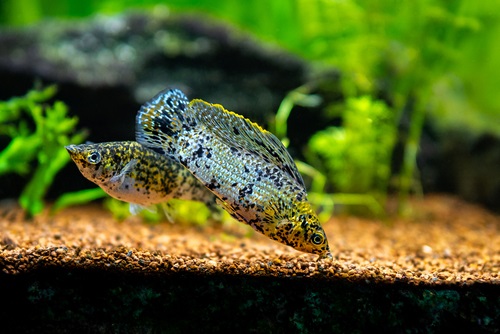
A very important thing to note is when your Molly is pregnant, she will need more food. Another good way of ensuring your Molly fish gets the optimum nutrition throughout the pregnancy process is to feed fresh, live food, or pre-frozen protein.
The same rules of feeding apply when your fish is not pregnant. However, it’s good to feed your Molly in smaller quantities but more often as this keeps their energy levels up. You should certainly not just feed them flakes.
Reducing Stress In Pregnant Molly Fish
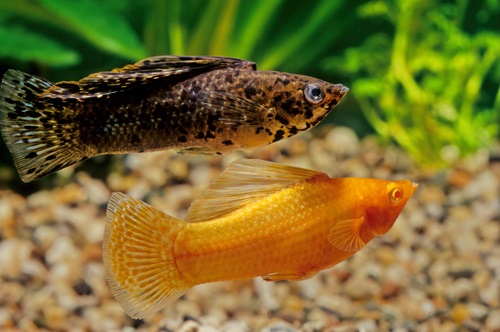
One of the best ways to ensure that your pregnant Molly fish can gestate and give birth without a hitch is to keep them free from stress.
By far one of the most obvious causes of stress to a female pregnant Molly is male fish trying to impregnate her. The effort she spends on avoiding them can actually prevent her from finding food. This can be solved simply by keeping your pregnant Molly in a breeding tank on her own.
Likewise, a similar thing can happen if your fish become territorial, your pregnant Molly may get stressed by other fish or simply by regular Molly behavior, although remember these guys are normally peaceful creatures.
Either way, these issues can be avoided with a separate breeding tank.
Dirty Water
One of the other main causes of stress to Molly fish is dirty water. Remember that your breeding tank should be held to the same rigorous conditions as your main tank. This means ammonia, nitrates, and nitrites can be kept at zero – you can test all these with a shop-bought kit.
Author’s Note: Keep your water clean by changing it every week. Use an aquarium vacuum to remove a third of the water and replace it with fresh. It is important to keep up with regular water changes your Molly fish will be pregnant for over two months – this means that they will spend a good amount of time in the breeding tank.
The Labor Process
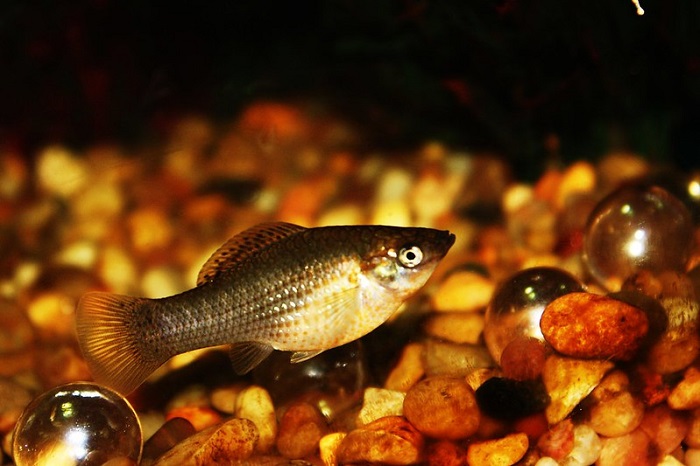
Overall you will notice your Molly fish hiding and losing appetite before giving birth.
In terms of the actual labor process, it is relatively surprising. This is because Molly fish fry are large, and they exit the mother’s body in a curled-up shape. They are able to swim slightly even as soon as they are born.
You will see contractions (your Molly fish’s body will start quivering) and she will hang stationary and motionless in the water. You will then notice fry are pushed out of the Molly fish’s body from near the anal fin.
Is It Normal For Some Fry To Die?
The unfortunate answer to this question is yes, it is likely that no matter how well you look after your fish or set up the tank, it’s more common than not to lose some fry during the delivery process.
That’s why to ensure enough fry survive to adulthood, your Molly fish produces lots of eggs.
Author’s Note: You may see a yellowish substance emerge along with the fry when your Molly fish gives birth. This is egg yolk and it is a normal part of the birthing process. It was present in the uterus with the fry and it is simply getting expelled.
Looking After Baby Molly Fish
So, your Molly fish has safely given birth to all of the fry. Mollies are easy to fish to breed. However, next up is the challenge of looking after the fry.
Molly fry are very hardy and they can be fed on infusoria and baby brine shrimps. They are not yet large enough to eat free swimming live food. Infusoria is a mix of microscopic aquatic organisms similar to what fish fry eat in the wild.
It’s very important to remove the mother fish from the breeding tank at this point. Unfortunately, Molly fish eat their young. This is why it is important to use a separate tank from the start. As the fry grows, you will find they have similar needs to adult fish.
Bottom Line
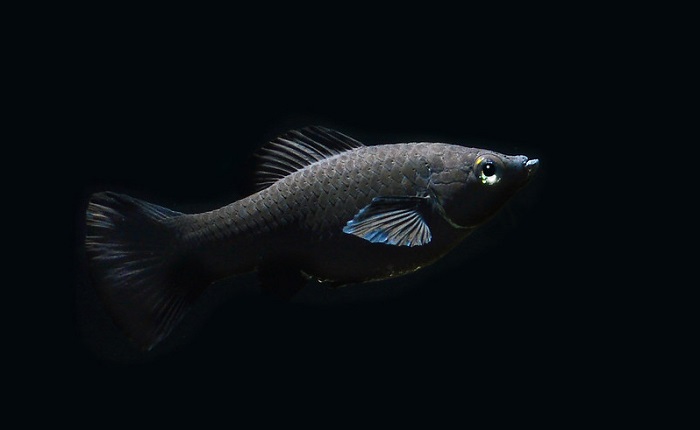
Molly fish are easy to breed, but like with any fish, taking good care of them and paying attention throughout the gestation period gives them the best quality of life possible. It’s a myth that fish die easily – too often, they simply don’t receive adequate care.
Hopefully, this guide will show you how to give them the optimum care – and end up with a new generation of Mollies on your hands.


